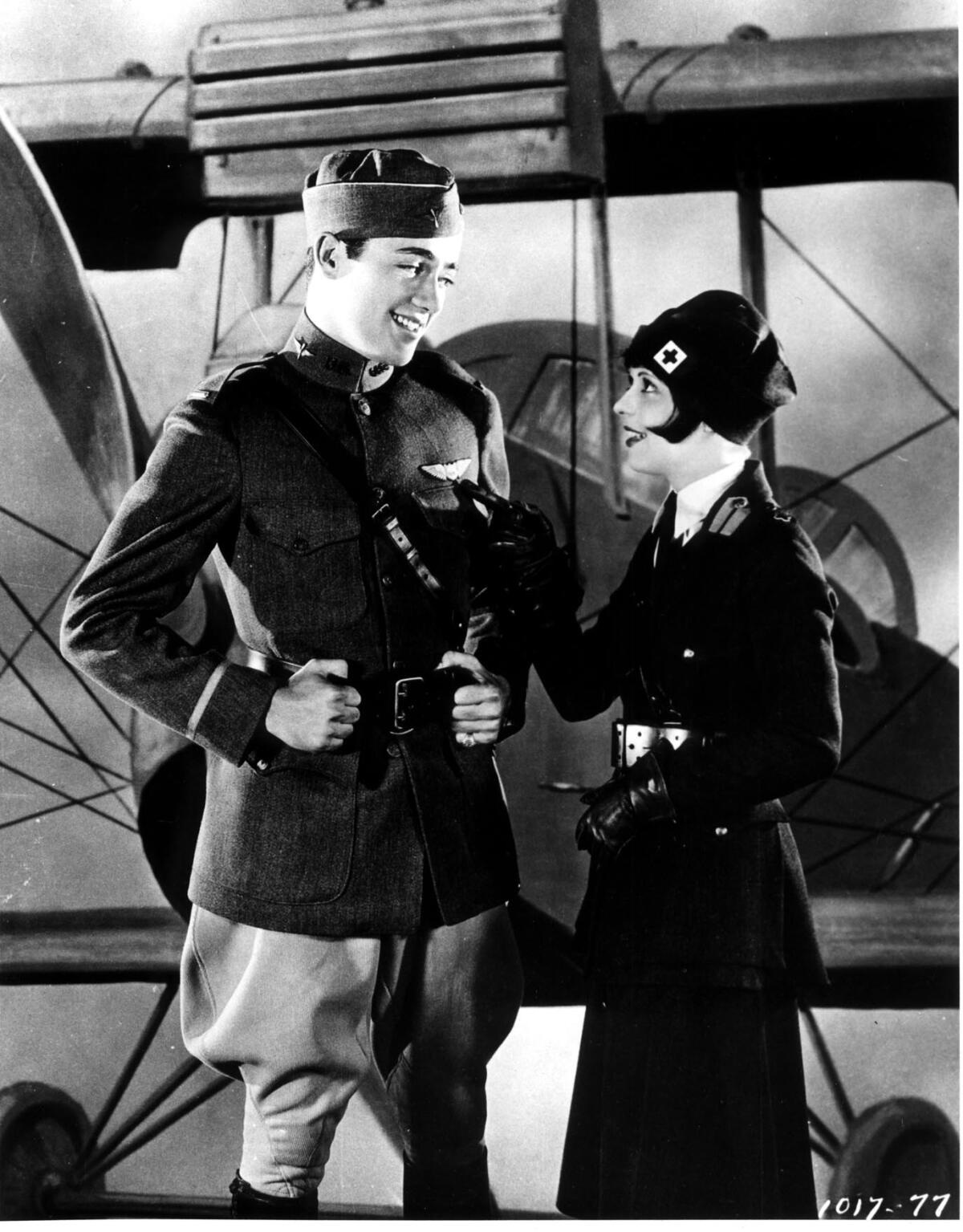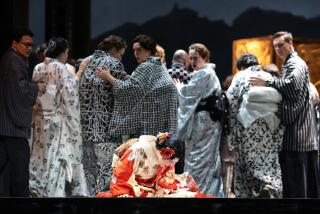From the Archives: Air spectacle thrills throng: ‘Wings’ spells awe-inspiring experience

- Share via
The spectacle of the season!
“Wings” assumes that designation. It is huge, imposing and at times well-nigh monumental.
“Wings” began its showing last night at the Biltmore theater. The large throng that congregated for the rare event of a Sunday opening for a film feature were overwhelmed by the magnificence of this air epic.
It is a startling blending of almost bewildering effects, sound and action for which there has so far been no equal.
“Wings” is a feature produced at a cost approaching I believe some $2 million by the Paramount organization. It was directed by William A. Wellman, not hitherto listed in the annals of the moviewise famous. It is an adaptation of a story by John Monk Saunders, devised by Hope Loring and Louis D. Lighton, and the cast, with very few exceptions, notably that of Clara Bow, is not a star cast in the familiar acceptance.
The picture dramatizes the airplane. There is no other object perhaps that could be linked in a more perfect way mechanically with the present.
The war is the background, but though there has been war picture upon war picture, this is bound by the very character of its aerial panorama to be reckoned essentially a novelty.
Young romance
The big moment in “Wings” arrived comparatively early in the presentation.
There is footage allotted first to the planting of a somewhat conventional wartime plot, concerning a quadrangle youthful love theme. There is some rather enlivening comedy for which El Brendel, noted as a vaudeville entertainer, is chiefly responsible.
One is introduced to Clara Bow, as a flapper heroine, unfortunately all too obvious. One meets Charles Rogers and Richard Arlen, rivals for the social belle of the town, played by Jobyna Ralston.
In other roles are Henry B. Walthall, Julia Swayne Gordon, Gary Cooper, George Irving and Hedda Hopper. As far as genuine acting goes, a few bits of emotion expressed by Walthall are clearly outstanding.
This is all incidental, however, to the main effect, namely the first war raid of the Americans.
Enlarged screen
For this scene, an enlarged screen is used. Behind the stage, there is the incessant staccato hum and rat-tat-tat in the imitation of the flying craft. Before the vision there is bewildering, dizzy motion. One is lifted virtually from one’s seat in the theater by the massive and overwhelming double effect. Eye and ear are appealed to with a force that is nerve-racking — the simulation of machine gun fire, shrieking shells, thunderous explosives. It is a sensation without parallel in the world of make-believe.
Had “Wings” nothing to offer except this one scene, it would probably be reckoned a great picture — and more probably a great show. The episode demolishes all rules of beauty and order in the creating of entertainment, but the result’s nothing short of momentous.
Spectacle irresistible
“Wings” is bound to go down in the future annals of the screen as the first triumphant air picture. It has the motive power of a huge and progressive industry behind it. The scenes above the clouds throughout are magnificent. One does not always follow easily all the details of the action itself, but in mass grandeur it exerts a sway irresistible.
One wishes this film could have possessed a more striking story and that the characterizations could’ve been expressed as vigorously and consistently as is the film’s drama of battle. Presently, however, the plot is designed for so-called popular approval, and except for incidental episodes, and a really tragical and appealing final sequence, lacks in vitality.
In the world of the everyday and especially in the world of war, the two characters portrayed by Charles Rogers and Richard Arlen would almost be reckoned simplish. The sentimentality of the scenes together is occasionally blatant and seeing the picture one welcomes the frequent returns to the skies where the machine guns rattle the rhythm of death and battered planes go careening down through the mist in pathetic and crippled flight to the earth.
Air warfare threat
Certainly, “Wings” soars beyond human experience. It sends home too a lesson of the horror of past war and suggests the intensifying of those horrors in any war that might in the future eventuate. There is great and significant drama in the fact that the one American shoots down another, believing that he is an enemy because of the appearance of the plane in which he is making his escape from behind the inimical lines. This incident could all too rapidly happen. It spells a tragedy of an essential sort. One can overlook many of the faults for this one big dramatic thought, which is worth every foot of the picture.
“Wings” is unquestionably the dazzle and pyrotechnics of the screen fulfilled in a new sphere, and teamed with 20th century timeliness.
For the aerial feats achieved — the crashing of the planes, the blowing up of the great observation balloons, the brilliance of its superterrestrial panorama — it redounds to the enormous credit of its director, Mr. Wellman. He will be eminently worthy of the title of a pioneer in a new type of visualization.
Aircraft elusive
Aircraft have hitherto eluded the camera, but in this picture they have been caught in action as never before, and the impression of being at a perilous altitude above the earth has been given a splendid reality.
Clara Bow, as the flapper heroine, did earnestly and sympathetically all that could be done to make the character genuine. I’m afraid, however, that the task would be a little beyond any actress, even so good a one as Miss Bow has grown to be. Rogers and Arlen in isolated scenes did work of interest. The bubble episode where Rogers imbibes too freely has a note of uniqueness, and at least proved laughable.
The training field scenes are abundantly enjoyable, making the earlier part of the picture amble along very acceptably. Gunboat Smith contributed to the comedy of these with, of course, El Brendel.
Nigel De Brulier and Arlette Marchal are excellent in a few moments toward the close. Gary Cooper, now a star, has only a bit in this picture.
The musical setting was composed and synchronized by John S. Zamecnik, and the orchestra is directed by Luigi E. De Francesco, but the technicians operating the mechanical effects behind the scenes are perhaps the ones who add the most assailingly to the atmosphere of this unusual production.
More to Read
Only good movies
Get the Indie Focus newsletter, Mark Olsen's weekly guide to the world of cinema.
You may occasionally receive promotional content from the Los Angeles Times.










